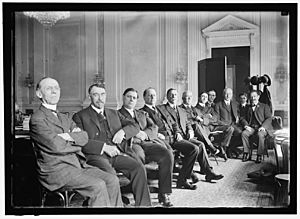Pujo Committee facts for kids
The Pujo Committee was a special group of lawmakers in the United States. They worked from 1912 to 1913. Their job was to look into something called the "money trust." This was a group of powerful bankers and money experts on Wall Street. People believed they had too much control over the country's money.
A congressman named Charles Lindbergh Sr. asked for this investigation. Then, Congressman Arsène Pujo from Louisiana was chosen to lead a special team. This team was part of the House Committee on Banking and Currency. The committee's findings were very important. They helped lead to new laws. These included the Sixteenth Amendment (which allowed a federal income tax), the Federal Reserve Act, and the Clayton Antitrust Act.
Contents
Why the Pujo Committee Was Formed
In the late 1800s, many people worried about the power of big banks. They also worried about large companies that controlled entire industries. These were called "monopolies." By 1911, Congressman Charles August Lindbergh said that a banking trust existed. He believed it needed to be investigated.
On February 7, 1912, a group of lawmakers decided to start an investigation. They passed a special rule called House Resolution 405. Soon after, Arsène Paulin Pujo was put in charge of the "Money Trust" investigation. Pujo then created a plan for how the investigation would work. Lawmakers voted 268 to 8 to approve his plan.
Key People in the Investigation
A lawyer named Samuel Untermyer strongly supported this investigation. He encouraged Lindbergh to keep pushing for it. Untermyer later became the main lawyer for the committee. Even though it was called the Pujo Committee, Arsène Pujo had to leave early. His wife became sick in March 1912. So, Representative Hubert D. Stephens from Mississippi took over as the leader.
The committee originally wanted to look at all loans over $1,000,000 from 1905 to 1912. However, they only received a small part of the information they needed. This made their investigation harder. They focused on three main areas:
- How banks handled checks (clearing houses)
- The New York Stock Exchange
- How wealth was becoming concentrated in a few hands
The committee started questioning witnesses on May 16, 1912.
What the Pujo Committee Found
Problems with Clearing Houses
The committee found that groups of banks in New York were gaining too much power. These groups were called "clearing house associations." They helped banks process checks. The committee said these associations made it hard for smaller banks to compete. They had strict rules for who could join. They also had unfair rules for their members.
For example, banks that were not members had to use a member bank to clear their checks. This meant a single big bank could decide the future of a smaller bank. If the big bank refused to help, the smaller bank was in trouble. This rule allowed big banks to stop new, smaller banks from growing. The report even mentioned the Panic of 1907. This financial crisis started when a big bank refused to help the Knickerbocker Trust Co. clear its checks.
Issues at the New York Stock Exchange
The committee also looked at the New York Stock Exchange. They found similar problems there. Certain rules made it hard for companies to list their stocks. These rules affected both members and non-members of the exchange.
The committee also found a lot of "unhealthy speculation" and price manipulation. This means large groups of people worked together to unfairly raise or lower stock prices. They did this to make money for themselves. Sometimes, these actions even caused companies to fail.
Too Much Power and Money in Few Hands
One of the biggest findings was about the concentration of wealth. The committee found that banks were merging, and the same people were serving on many different company boards. This was called "interlocking directorates." These actions led to a huge amount of money being controlled by a few powerful people.
The report showed that the twenty largest banks held almost 43% of all banking money in America. They also found that "180 individuals" held "341 directorships in 112 corporations." These corporations controlled a massive $22 billion in resources. The committee concluded that a system called "Banking Ethics" actually stopped competition among banks.
The Pujo Committee's report came out in 1913. It said that a small group of powerful financial leaders controlled major industries. These included manufacturing, transportation, mining, communication, and finance in the United States. The report specifically named J. P. Morgan, George F. Baker, and James Stillman. It said these three men, through seven banks, controlled about $2.1 billion. The report also showed that a few men controlled the New York Stock Exchange. They also tried to get around laws about trade between states.
The report also mentioned other important bankers. These included Paul Warburg, Jacob H. Schiff, Felix M. Warburg, Frank E. Peabody, William Rockefeller, and Benjamin Strong, Jr.. The report highlighted that J. P. Morgan's group controlled over $22 billion in resources. This was done through 341 directorships in 112 companies.
Impact of the Pujo Committee
Even though Arsène Pujo left Congress in 1913, the committee's findings had a big impact. They helped people understand the need for change. This public support led to several important new laws:
- The Sixteenth Amendment was approved in 1913. This allowed the government to collect a federal income tax.
- The Federal Reserve Act was passed in 1913. This created the Federal Reserve, which helps manage the country's money supply.
- The Clayton Antitrust Act was passed in 1914. This law made it harder for big companies to form monopolies and stop competition.
The committee's findings were also shared widely in a book. It was written by Louis Brandeis and called Other People's Money and How the Bankers Use It.


